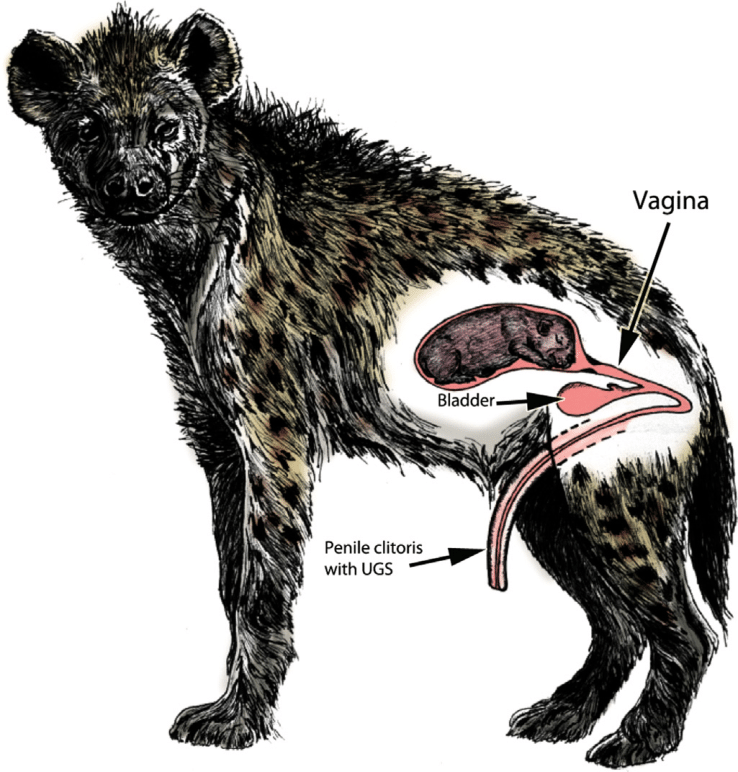Nature is full of fascinating and sometimes brutal adaptations, but few are as shocking as the birthing process of the spotted hyena. You might think childbirth is a universally painful experience, but hyenas take it to an entirely new level.
Female hyenas have one of the most unusual reproductive anatomies in the animal kingdom—what appears to be a penis is actually an elongated clitoris, known as a pseudo-penis. This rare adaptation makes mating, birth, and survival incredibly difficult for both mother and cubs.
Let’s dive into the science, struggles, and evolutionary mysteries behind why hyenas experience one of the most challenging births in the wild.
Hyenas’ Unique Reproductive Anatomy: A Bizarre Evolutionary Twist

The female spotted hyena (Crocuta crocuta) is unlike any other mammal when it comes to reproduction. Unlike most female mammals, hyenas have no external vaginal opening. Instead, their labia are fused together, forming a pseudo-scrotum, and their clitoris is elongated into what resembles a fully functional penis.
This means that both mating and giving birth happen through a narrow, tough, and inflexible canal—a structure that poses serious risks to both mother and cubs.
But why would evolution favor such an extreme adaptation? The answer lies in hyena social structure and dominance.
The Link Between Dominance and Reproductive Anatomy
Hyenas live in strict matriarchal societies, where females outrank males in dominance. The unusual reproductive anatomy is believed to be an evolutionary adaptation linked to social hierarchy.
- A Display of Strength: A larger pseudo-penis might act as a dominance signal, making it clear which females hold power in the clan.
- Hormonal Influence: Female hyenas have higher testosterone levels than males, leading to increased aggression and dominance over the pack.
- Mating Challenges: Males must earn the right to mate, as females control copulation with their complicated anatomy.
Video : Hyenas’ Brutal Birth: The Most Painful Labor in the Animal Kingdom
While this system gives females power, it comes at a terrible cost when it’s time to give birth.
Why Giving Birth Is So Dangerous for Hyenas
Imagine trying to push a newborn through a passage too small, too rigid, and highly prone to tearing. That’s exactly what female hyenas go through every time they give birth.
Here’s what makes hyena birth so deadly:
- A Super Tight Birth Canal
- The pseudo-penis acts as the only birth canal, but it is long, narrow, and lacks the elasticity of a normal vagina.
- This makes labor extremely difficult and painful, with a high chance of the tissue tearing.
- First-Time Mothers Face the Worst Risks
- Many first-time mothers do not survive the birthing process due to severe ruptures.
- Those who do survive often suffer from long-term damage to their reproductive organs.
- High Cub Mortality Rate
- A staggering 60% of hyena cubs suffocate before they are fully delivered.
- Since the birth canal is so tight, cubs often become trapped and die before they can emerge.
- A Painful Recovery Process
- After birth, the pseudo-penis often ruptures completely, forcing it to heal over time.
- Mothers suffer weeks of pain and vulnerability while their bodies recover.
Despite these brutal challenges, hyenas continue to thrive, and their unique reproductive system has remained largely unchanged for millions of years.
How Do Hyenas Mate? The Struggles of Reproduction

If you think birth is difficult for hyenas, mating is no easier. Males must overcome significant anatomical and social obstacles just to reproduce.
- Males Are Submissive to Females
- Unlike in many species where males dominate, male hyenas are the weaker sex in both power and ranking.
- They must approach females cautiously, often displaying submissive behavior to gain approval.
- Navigating the Pseudo-Penis
- Since females have no traditional vaginal opening, males must carefully maneuver through the pseudo-penis to copulate successfully.
- This requires both patience and precise positioning, making it one of the most complex mating processes in the animal world.
- Only the Strongest Males Get to Reproduce
- Males don’t fight each other for dominance like in other species. Instead, they must earn the female’s trust over time.
- Females choose mates based on persistence, patience, and respect, ensuring only the most determined males pass on their genes.

Given how dangerous and inefficient the reproductive process is for hyenas, one might wonder why evolution hasn’t corrected this issue.
The answer lies in survival strategy and social dynamics.
- Matriarchal Control Guarantees Stronger Cubs
- By limiting mating to only the most persistent males, female hyenas ensure that their cubs inherit strong genetics.
- This method prevents weaker genes from spreading, keeping the species robust.
- Higher Testosterone Helps With Survival
- The same high testosterone that makes birth difficult also makes female hyenas stronger and more aggressive.
- This aggression helps protect their cubs and maintain dominance in their environment.
- Fewer Cubs = More Resources
- Since many cubs don’t survive birth, the ones that do are often given more attention and resources.
- This ensures the strongest cubs make it to adulthood, increasing the clan’s overall survival rate.
The Resilience of the Spotted Hyena
Despite their brutal birthing process, hyenas have thrived for millions of years. Their ability to adapt, dominate, and survive proves just how powerful evolutionary trade-offs can be.
- They are among Africa’s most successful predators, competing with lions for food.
- Their clans are ruled by powerful females, ensuring only the strongest members survive.
- They have some of the most advanced social structures in the animal kingdom, making them highly intelligent and strategic.
Video : The Most Extreme Births In The Animal Kingdom
Conclusion: Nature’s Ultimate Test of Survival
Hyenas are proof that nature often prioritizes survival over comfort. Their unique reproductive anatomy, extreme birthing challenges, and dominance-driven society have allowed them to thrive despite overwhelming odds.
While their birth process remains one of the most painful and deadly in the animal kingdom, it also ensures that only the strongest females and cubs survive.
So the next time you see a spotted hyena, remember—they’re not just fierce scavengers. They’re survivors of one of evolution’s toughest reproductive challenges.
Homem dá salário a mulher com filho pedindo dinheiro para uma passagem — no dia seguinte, uma grande limusine branca para em sua casa

Quando um homem trabalhador comum se deparou com uma mulher pedindo esmolas com seu filho, ele não imaginou que seus caminhos se cruzariam por um motivo. Depois que ela lhe pediu dinheiro, ele deu tudo o que tinha, garantindo seu retorno seguro para casa. Mas o que aconteceu depois o deixou chocado!
Em uma noite fria de novembro, Greg, um robusto trabalhador da construção civil com manchas grisalhas na barba, deixou seu local e foi em direção à estação de trem. Mal sabia ele que uma interação na estação estava prestes a mudar sua vida para sempre.

Greg na estação de trem | Fonte: Midjourney
Aos 40 anos, o homem exausto tinha resistido o suficiente na vida para reconhecer as dificuldades quando as via, mas raramente se estendia além da simpatia educada. Ele tinha uma esposa, Diana, uma filha de 15 anos, Jamie, e um filho de 12 anos, Alex, esperando por ele em casa, e a cada dia ele trabalhava duro para economizar para o futuro deles.
Naquele dia, porém, algo incomum chamou sua atenção.
Enquanto ele se movia pela multidão agitada da estação, uma mulher segurando um bebê estava parada na saída, sua figura parcialmente sombreada na luz fria da noite. Ela parecia deslocada, bem vestida, mas desgastada e fora de estação, como se não tivesse planejado passar o dia ali.

Lilly e Matthew parados na estação de trem | Fonte: Midjourney
Suas mãos tremiam enquanto ela apertava o bebê perto. Greg parou e observou-a, debatendo se deveria parar. Quando a mulher de aparência cansada finalmente encontrou seu olhar, seu rosto se iluminou com um breve lampejo de esperança.
“Com licença, senhor?” Sua voz estava trêmula, carregando um tipo de desespero que era difícil de ignorar. “Você poderia, POR FAVOR, me emprestar algum dinheiro para uma passagem? Tenho dinheiro em casa; só preciso chegar lá.”

Lilly implorando enquanto está com Matthew na estação de trem | Fonte: Midjourney
Greg não respondeu imediatamente. O peso do seu salário, recém-sacado e guardado com segurança no bolso do casaco, parecia mais pesado do que o normal. Ele já tinha visto pessoas sem sorte na cidade antes, e muitas vezes ele se preparou contra os pedidos delas.
No entanto, havia algo genuíno e diferente em seu tom e na maneira como ela segurava a criança cuidadosamente embrulhada, que não parecia ter mais de três anos. Com um suspiro, Greg decidiu fazer algo que raramente fazia: deu um passo à frente.

Greg falando com alguém | Fonte: Midjourney
“Tudo bem. Vamos começar pegando algo para vocês dois comerem”, ele disse, surpreso com suas próprias palavras. O rosto dela se encheu de alívio, e ela assentiu. Contra seu melhor julgamento, Greg decidiu ajudar.
Eles foram até um pequeno café ali perto.
“Peça o que quiser”, Greg ofereceu. “Não se preocupe com isso.”
A mulher lhe lançou um olhar agradecido. “Obrigada, de verdade. Meu nome é Lily, e este é meu filho, Matthew.”
Greg sorriu. “Prazer em conhecer vocês dois. Eu sou Greg.” Ele sinalizou para o garçom, fazendo pedidos para si mesmo, Lily e seu filho, embora não estivesse particularmente com fome.

Uma garçonete parada ao lado depois de anotar o pedido de comida de Greg | Fonte: Midjourney
Lily e Matthew devoraram suas refeições com uma fome que desmentia sua aparência externa. Mas Lily não estava enchendo a boca; ela comeu de uma maneira elegante, mas faminta, revelando como ela não comia nada há algum tempo.
Enquanto comiam, Greg tentou puxar assunto. “Então, para onde você está indo?”
Lily hesitou, olhando para o filho, que estava feliz terminando o chantilly e as frutas de uma tigela.
“Em casa, espero. Tem sido… um momento difícil.” Ela lutou com suas palavras, seu olhar caindo para suas mãos.

Lily e Greg conversando | Fonte: Midjourney
“Não tenho meu telefone nem minha carteira. Não era minha intenção acabar aqui, abandonado. Meu plano desmoronou e, de repente, eu não tinha nada.”
Greg assentiu. “Parece difícil. Tem certeza de que ficará bem quando chegar em casa?”
Ela olhou para cima, seus olhos molhados de gratidão. “Sim. Obrigada. Você não sabe o quanto isso significa para mim.”
Sem pensar duas vezes, em um momento de generosidade, Greg tirou o envelope contendo seu contracheque. Algo lhe disse que aquela mulher precisava mais do que ele naquele momento.

Greg segurando um envelope | Fonte: Midjourney
“Aqui”, ele disse, pressionando o envelope que continha seu endereço residencial e seu cheque inteiro nas mãos dela. “Pegue isso; é parte do dinheiro que tenho economizado para a educação dos meus filhos, mas posso ver que você e Matthew precisam mais agora. Cheguem em casa em segurança e não se preocupem em pagar de volta.”
Os olhos de Lily se arregalaram quando ela percebeu a magnitude do presente dele. “Eu… eu não posso aceitar isso. Você nem me conhece.”
Como se estivesse tendo uma experiência extracorpórea, Greg observou enquanto ele ignorava as preocupações dela.
“Basta chegar em casa em segurança. É a coisa certa a fazer.”

Greg falando com alguém | Fonte: Midjourney
Antes que ele pudesse mudar de ideia, Lily o abraçou e sussurrou um sincero “Obrigada”, com lágrimas nos olhos. Ela se levantou e saiu correndo com o filho, desaparecendo na multidão noturna da cidade antes que ele pudesse responder.
Greg voltou para casa e viu as sobrancelhas erguidas de Diana e a curiosidade de Jamie enquanto ela e Alex se reuniam em volta da mesa de jantar. Enquanto ele explicava o que aconteceu, o rosto de sua esposa mudou de confusão para choque e preocupação.

Diana parece chocada enquanto está sentada à mesa de jantar | Fonte: Midjouney
“Você doou nossas economias? Greg, precisávamos desse dinheiro para as crianças”, ela disse, com a voz tensa de ansiedade.
Ele esfregou as têmporas. “Sei que parece loucura, mas parecia certo. Ela parecia… genuína.”
Diana suspirou, claramente não convencida, mas deixou passar, a tensão persistindo entre eles durante o jantar. Naquela noite, ele ficou deitado na cama, olhando para o teto, imaginando se havia cometido um erro terrível enquanto ponderava sobre o futuro dos filhos.
Mas ele não sabia que sua conexão com Lily ainda não havia acabado.

Greg preocupado e acordado | Fonte: Midjouney
No dia seguinte, a vida retomou seu ritmo regular. Greg foi trabalhar, mantendo a cabeça baixa enquanto colocava toda sua energia no trabalho. Quando chegou em casa, a exaustão pesava sobre ele. Assim que ele e Diana se sentaram para um almoço tranquilo, uma comoção do lado de fora chamou sua atenção.
Sua esposa espiou pela janela, boquiaberta.
“Greg, talvez você queira ver isso.”
Ele se juntou a ela na janela, ficando de queixo caído ao ver uma enorme e reluzente limusine branca estacionada em frente à modesta casa deles.

Uma limusine branca estacionada em frente à casa de Greg | Fonte: Midjourney
A porta se abriu, e um homem em um terno preto elegante saiu, seu comportamento calmo, mas profissional. Eles observaram enquanto ele caminhava até a porta e batia. Greg abriu a porta cautelosamente, incerto sobre o que esperar.
“Ah, posso ajudar?”
O homem ofereceu um sorriso educado. “Olá, senhor. Você é Greg?”
Greg assentiu, ainda confuso.
“Estou aqui em nome da Srta. Lily. Acredito que você a ajudou ontem na estação de trem.”

Um homem de terno segurando uma pasta | Fonte: Midjourney
Uma mistura de alívio e confusão tomou conta do rosto de Greg.
“Lily? Ela está… ela está bem?”
O homem assentiu.
“Sim, ela está mais do que bem, graças à sua gentileza. Ela é, na verdade, uma figura notável nesta cidade, uma espécie de celebridade, embora tenha passado por momentos difíceis recentemente.”
“Espera,” Diana interrompeu, juntando-se a Greg na porta. “Ela é uma celebridade? Mas por que ela ficou presa? E você sabe que ela pegou nosso dinheiro, certo?”

Diana chateada | Fonte: Midjouney
O homem fez uma pausa, escolhendo as palavras com cuidado.
“Lily já foi uma empresária de sucesso e construiu sua carreira do zero. Mas uma série de eventos infelizes, problemas legais, uma herança perdida e uma série de investimentos fracassados a deixaram quase sem dinheiro.”
Ele continuou: “Ela estava viajando incógnita, esperando encontrar um novo começo assinando um novo acordo comercial com um associado, mas as coisas deram errado durante a reunião.”

Um homem explicando as circunstâncias de Lily | Fonte: Midjourney
“O sócio comercial inescrupuloso tentou torcer o braço dela no acordo, e eles acabaram tendo uma briga. A Sra. Lily saiu abruptamente com raiva, deixando para trás sua bolsa com todos os seus cartões importantes, telefone e pertences”, explicou o homem da limusine.
“Ela não tem sido ela mesma nos últimos anos e deve ter caminhado um pouco com Matthew antes de perceber que não sabia onde estava. Àquela altura, já era tarde demais; ela se viu abandonada sem um centavo. Ela vagou pelas ruas por dias procurando por ajuda.”

Lily encalhada com Matthew | Fonte: Midjourney
Greg trocou um olhar atordoado com Diana, sem saber se acreditavam ou não no que tinham ouvido.
“Eu não tinha ideia. Ela parecia… como qualquer outra pessoa sem sorte.”
“É exatamente isso”, continuou o homem. “Ela não queria ser reconhecida ou tratada de forma diferente. Mas sua generosidade tocou um acorde nela.”
O homem enfiou a mão na pasta e tirou um envelope, entregando-o a Greg.

Um homem segurando um envelope | Fonte: Midjourney
“A Sra. Lily criou um fundo de bolsa de estudos para seus filhos. A educação dos seus filhos é totalmente financiada, e há um pouco mais para ajudar você de outras maneiras também.”
As mãos de Greg tremeram quando ele pegou o envelope, olhando para o conteúdo dentro. Diana soltou um suspiro, cobrindo a boca, enquanto olhava por cima do ombro dele. Seus anos de preocupação e orçamento cuidadoso pareceram evaporar em um instante, substituídos por uma silenciosa sensação de alívio.
“Por que… por que ela faria isso?” Greg perguntou, ainda tentando entender a reviravolta surreal dos acontecimentos.

Greg chocado ao segurar um envelope | Fonte: Midjouney
O homem sorriu, sua voz era gentil.
“Porque às vezes, um pequeno ato de gentileza vale mais do que toda a riqueza do mundo. Ela queria que você soubesse que sua compaixão salvou a vida dela, e agora ela espera mudar a sua.”
A garganta de Greg ficou apertada enquanto ele lutava para responder. “Eu só… eu não esperava nada em troca. Eu só queria ajudar.”
O homem estendeu a mão em um gesto de despedida.
“É exatamente por isso que ela queria retribuir. Às vezes o universo tem uma maneira de recompensar aqueles que doam desinteressadamente.”

Um homem sorrindo enquanto caminha para fora | Fonte: Midjourney
Enquanto a limusine se afastava, Diana envolveu Greg com os braços, seus corações cheios de gratidão e espanto. Seu ato de gentileza floresceu em um futuro mais brilhante do que eles jamais imaginaram.
Greg se virou para sua esposa, sua voz quase um sussurro.
“Acho que nunca sabemos o quanto de bem um pouco de gentileza pode fazer.”
Diana assentiu, com lágrimas brilhando em seus olhos.
“E às vezes, isso retorna para você dez vezes mais.”

Greg e Diana parecem felizes | Fonte: Midjouney
Enquanto a história de Greg tem um final simples e gratificante, no conto a seguir, um Brandon sem-teto escolhe ser altruísta com suas últimas moedas apenas para receber uma recompensa inesperada . Infelizmente, a recompensa leva a ameaças, extorsão e sofrimento antes do drama terminar.
Este trabalho é inspirado em eventos e pessoas reais, mas foi ficcionalizado para fins criativos. Nomes, personagens e detalhes foram alterados para proteger a privacidade e melhorar a narrativa. Qualquer semelhança com pessoas reais, vivas ou mortas, ou eventos reais é mera coincidência e não intencional do autor.
O autor e a editora não fazem nenhuma reivindicação quanto à precisão dos eventos ou à representação dos personagens e não são responsáveis por nenhuma interpretação errônea. Esta história é fornecida “como está”, e quaisquer opiniões expressas são as dos personagens e não refletem as opiniões do autor ou da editora.



Leave a Reply